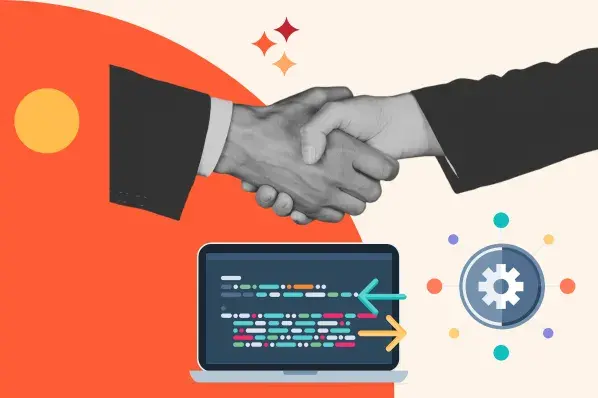What is an API?
An Application Programming Interface (API) is a software-to-software interface. This type of interface provides a secure and standardized way for applications to talk to each other and deliver information or functionality to each other without user intervention.
What is an SDK?
When evaluating options for creating or adding functionality to your application, you might have heard of another three-letter acronym: SDK. Below let’s define what an SDK is, how it’s different from an API, and when to use one over the other (or both!).
Say you build an app and want to add maps. You could build them from scratch — but that would require lots of time, experience, and budget. An easier and cheaper option would be to use Google’s Map SDK. This SDK automatically handles access to the Google Maps servers, map display, and response to user gestures such as clicks and drags so you can add detailed, interactive maps to your app in less time.
By simplifying the development process, SDKs not only make building applications for a specific platform easier — but they also make it more attractive to developers. Apple and Android offer SDKs so developers can build their apps for their respective devices, for example. If Apple only offered SDKs, more developers would likely develop apps for Apple instead of Android devices.
Now that we understand what an SDK is and its benefits, let’s take a closer look at how it differs from an API.
Difference between SDK and API
While both SDKs and APIs are designed to shorten the development cycle of an application, they differ in key ways.
An SDK is basically a toolbox with everything third-party developers need to write applications for a specific platform or programming language. This toolbox typically includes at least one API.
An API is an interface that enables different applications to work together. Developers typically use an API to extract information or functionality from a specific platform and use it in their own applications. So, while they can’t use an API to create a completely new application, they can use it to enhance an app.

To make sure we understand the difference, let’s look at an example: comparing Facebook’s SDKs to its APIs.
Facebook SDK vs. API
Facebook offers both SDKs and APIs to make it as easy as possible for developers to build apps using the Facebook platform.
To understand how they differ, let’s take a closer look at four of its most popular APIs:
- Business Manager API: This API allows you to manage Facebook assets, permission controls, and ad campaigns for multiple pages and ad accounts.
- Pages API: This API allows you to manage a business' official presence and community on Facebook. With this API, apps can access and update a Facebook Page's settings and content, create and get Posts, get Page insights, and much more.
- Marketing API: This API helps you advertise on Facebook by automating ad management and creation, offering custom dashboards for insights and performance, and more.
- Instagram Graph API: This API allows you to manage a business’ or individual’s organic presence on Instagram. With this API, you can get and manage published photos, videos, and stories; moderate comments; discover @mentions; and more.
You can use any one of these APIs individually. But if you use multiple, then adopting and keeping them all up-to-date across various platforms would be time-consuming. You could use Facebook’s Business SDK to make this process more efficient. This kit bundles all four of the APIs above to make it easier to implement and manage them.
Now that we better understand the difference between an SDK and API, let’s take a closer look at their ideal use cases.
When to Use API vs. SDK
When deciding whether an API or SDK would best meet your needs, it’s important to remember that it’s not necessarily an either-or situation. In fact, an API is often packaged in an SDK.
Let’s say you want to build a web app that enables users to sign in using their Facebook account info. In that case, you could manually build a login flow — but that would require you to create a way of storing when a person has logged in, confirming their identity, and a whole lot else. To automate most of this process, you can use Facebook’s JavaScript SDK. This SDK will help you build and implement the sign-in feature in your app.
Included in this kit is an API. This API allows your app and Facebook to communicate with each other so the sign-in can happen. For example, their access token needs to be verified to confirm the identity of the user who logged into Facebook to log in to your app. This verification process is automated thanks to the Facebook Graph API, which inspects and indicates whom the token was generated for and by which app. Without this API, the sign-in process couldn’t continue.
Summing Up SDK vs. API
Using an SDK to build an app differs from using an API to enhance an app. Deciding which one is right for you will depend on your time, budget, current coding and design skills, and willingness to develop those skills.
To help you make this decision, we’ll summarize the key differences between the two solutions below.
| SDK | API | |
| Acronym for | Software Development Kit | Application Programming Interface |
| Purpose | Provides all tools needed to build an application for a specific platform or programming language | Provides definitions and protocols that allow software components to talk and interact with each other |
| Difference | Set of software-building tools that includes API | Can be standalone solution or included in SDK |
| When to use | Building a new application | Enhancing an application |




![How to get a YouTube API key [tutorial + examples]](https://53.fs1.hubspotusercontent-na1.net/hubfs/53/%5BUse%20(1)-4.webp)
.webp)






